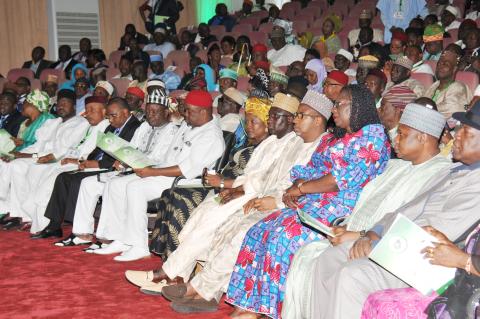
One would therefore have thought that these compromises in the interests of citizens would have been acceptable to the various factions of the ruling elites; but alas blinded by their own greed and selfish interests, motivated only by their own calculations of immediate gains or losses to treasuries over which they had absolute looting control, they were unable to agree to these forward-looking and people-centered consensus.
The contrived crisis which blew up and raised sensational storm over the report of the committee on devolution of powers at the recently concluded national conference brings to light in clear relief the fixation of the ruling elites and its various factions on unfettered access to the treasury in order to enable their treasury looting capabilities and dispensation.
What was the crisis really about? And why did I describe it as contrived, and deliberately self-made? First, some necessary clarifications; when Nigeria’s ruling class describes political restructuring and devolution of powers as contentious issues, they do not have in mind the interests of ordinary citizens; rather they have in mind, the renewed antagonistic contention over access to the treasury, and therefore to our collective wealth, which any changes to the structure or the nature of power relations will engender among the various factions and fractions of the ruling class.

So for instance when the issue of Local Government autonomy is discussed, it is never about whether LGAs are enough, enabled to perform their duties etc., but more about whether any changes to the Local Government process and structure from in terms of numbers and functions will translate into more or lesser resources allocated from the Federal center to the ruling elites. So the question becomes will these mean fewer resources to the Federal government and the State governments; and more resources available to those who control the state government and the politics of the state including who becomes Local Government officials?
Let us explore this local government autonomy issue further. A federation is always a relationship between two tiers of government, who constitute the Federating Units and the Federal Government; it does not limit the number of administrative levels to these two tiers, but implies the existence of further administrative levels particularly within the Federating Units, in this case the states.
It is in this light that for instance there is no contradiction between supporting Local Government Autonomy [within the federating units], and insisting that our federation must be a proper federation, whose relationships are defined between the Federal Center and the federating units, that is the two tiers of government within the federation.
That is why those who seek a radical transformation of our country in the interests of our people, pushed for the National Conference to adopt the two tier federation, with the states as the federating units, while also ensuring the retention and further strengthening of constitutional guarantees for the existence of a system of democratically elected local government within states as the federating units.
Section 7 of the present constitution already guarantees local government existence and autonomy, although it has always been observed in the breach by the ruling elites. This constitutional breach has been made possible because there are no constitutionally guaranteed penalties. Conference has now proposed provisions for such penalties, including not being able to access state allocation from the federation account where a state has no system of local governments, and or where such systems exist but are not democratically elected. Furthermore it also makes absence of a system of democratically elected local government system an impeachable offence, while also making section 7 with its new provisions justiciable.
So contrary to the claims of those among the elites who wish to deliberately misinform in order to continue to protect their control over the resource allocation process [which is presently three tiered] which the listing of the 774 LGAs in the present constitution makes possible for them; the decisions of conference after stiff opposition, not only ensures the guaranteed existence of local governments, but also ensures that states can easily create as many local governments as a state may require without this being dependent on the federal allocation formula or on the concurrence of other states, since federal allocation will no longer be tied to the number of LGAs existing in a state and listed in the constitution.
A new or fundamentally amended constitution dealing with this structural problem will also include provisions which provides that every state must by law establish a revenue mobilization and allocation committee, which shall determine the allocation formula between the state and its local governments, and which shall oversee the disbursement of this allocation; with the proviso that no state shall allocate less than 40% of the total revenue accruing to it for its local governments.
Nothing in this new proposed structure excludes the states from creating any number of administrative levels below the local government structure including in fact having community governments if they so desire.
To buttress the point that the establishing the appropriate structure of governance within the federation and the appropriate nature of power to be given to each tier of government and level of administration is not as contentious as the fight by the elites over the resources accruing to the federation and its units; it is important to note that resolutions had already been adopted on establishment of state police, state court of appeal as apex court at state level, removal of a number of issues either from the exclusive [federal list] to the concurrent [joint state and federal list] as well as to the residual [exclusive state list]. The import of all of these is that the polity will be significantly restructured and power within the federation significantly devolved.
So it was really such a self-serving contradiction introduced by the elite over the derivation and revenue sharing formulas, or over what I have consistently described as the appropriate and acceptable treasury looting formula for the ruling elites and its various factions and fractions.
Let me explain further; in proposing significant levels of political restructuring [including provisions for states to merge and for states to be created], as well as for sharing power among the tiers of government within the federation by significantly devolving power from the center to the federating units; conference already envisaged and proposed altered revenue allocation formula between the federation and its federating units. Thus from its present share of 52%, the committee proposed a reduction to 42%, while other proposals also came during the debate to reduce this further to 40% or infact 35% as the share of the federal government.
The implication of this is that what will now accrue to the federating units [in this case the states] will be either 58%, 60% or 65%; all with the proviso that no state shall allocate less than 40% of its total share of revenue from the federation account to its democratically elected system of local governments.
This point is important, because it means more resources will flow to states and less will be retained by the federal government which is performing less functions.
Now in comes the controversy over the derivation percentage from proceeds of exploitation of oil and gas resources. Conference already affirmed that the derivation principle apply to all minerals whether solid, liquid or gaseous; and had furthermore already resolved that the provisions of the Minerals’ Act which are more progressive should apply to all minerals including petroleum resources.
To ease solid minerals development conference had also recommended increasing the constitutionally established solid minerals development fund from its present 1.68% of the federation account to 5%., with proviso for state counterpart funding at a level to be agreed between states and the federal government for states to access the funds. Again this means more resources deployed to be used at the state levels, giving that solid minerals have now been proposed to be moved from the exclusive to the concurrent list.
The agitation for increase in the level of derivation from its current 13% is therefore to be understood also within this context. Conference had reached an initial consensus proposal for a 5% increase to 18%. And this would have been okay, because the reduction in the amount of funds available in the federation account for allocation to states arising from this proposed 5% increase would have been offset by the more than 10% increase in the allocation to states, as well as by the nearly 4% increase in the solid minerals development fund. Besides over time, and with the development of solid minerals exploitation across the country, a situation will be created whereby states will be able to earn significant incomes from solid minerals and would all be in a position to all increase the level of revenue accruing to them through increased quantity of the funds coming in through derivation.
Significantly too, the proposal to increase the National Stabilisation fund from the present 1.5% of the share accruing to the federal government from the federation account to 5%, and its disbursement to meet the challenges posed by instability and insurgency in the North East and other parts of the country would also have meant more resources available to states.
In proposing increase in derivation fund from 13% to 18% conference had also proposed that no less than 40 to 50% of funds accruing to states through the derivation fund must be spent on the communities where the exploitation is taking place and affected by the exploitation of the resources.
One would therefore have thought that these compromises in the interests of citizens would have been acceptable to the various factions of the ruling elites; but alas blinded by their own greed and selfish interests, motivated only by their own calculations of immediate gains or losses to treasuries over which they had absolute looting control, they were unable to agree to these forward-looking and people-centered consensus.
Even those who claimed to be agitating for increase in the derivation percentage on behalf of the people would not agree to, and recoiled from agreeing to a structure and process that will ensure that communities directly benefitted, and not just the elites cohering around the state government apparatuses.
It is this acrimonious contestation and inability to agree to these allocation principles and percentage shares, that is revealed it its entirety the humongous scope and scale of the gluttonous greed, rapacious selfishness, and light-fingered brigandage of this congenitally corrupt and administratively inept ruling class.
It is why we are once again forced to reach the conclusion that this ruling class is incapable of transforming this country, that it is historically incapable for making a success of the Nation building project, and that our survival as a viable nation depends entirely on the overthrowing and supplanting from power of this unpatriotic and un nationalistic ruling class, and the overturning of the self-enriching system over which it presides.
It is why we must hasten to take steps to take back Nigeria, by building a platform that can ensure our transition From protest to power.
It is our country damn it; let us organise and mobilise ourselves to take it back From these bands of pirates.
Follow me on Twitter: @jayegaskia and interact with me on Facebook: Jaye Gaskia & Take Back Nigeria.
Jaye Gaskia is National Coordinator of Protest To Power Movement [P2PM] & Co-Convener of the Nationwide Say No Campaign [SNC].